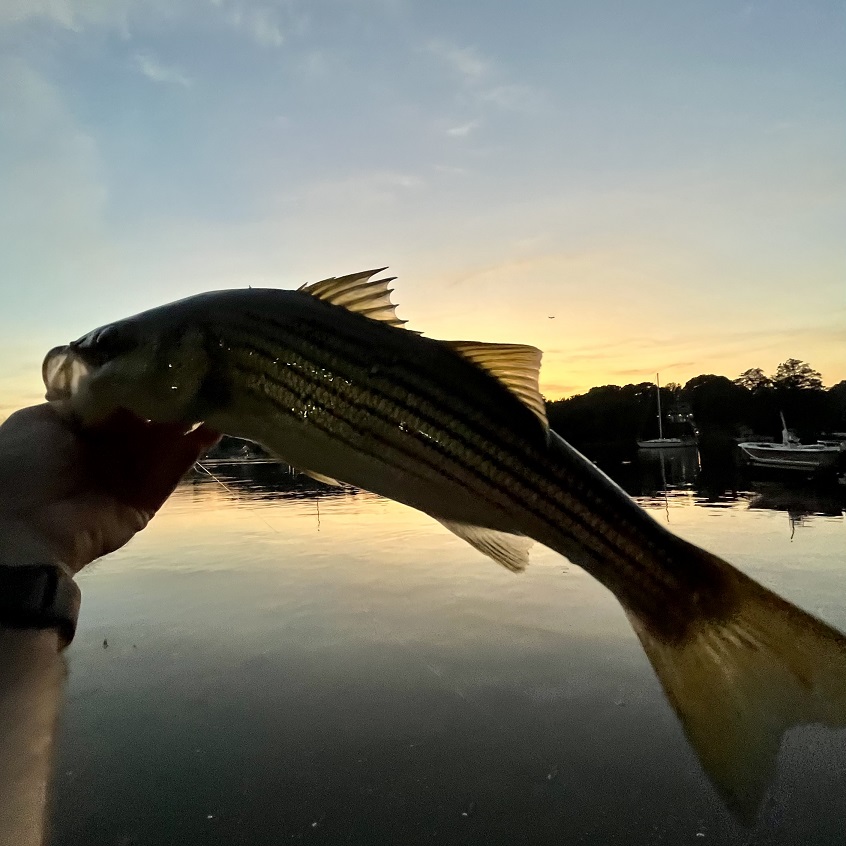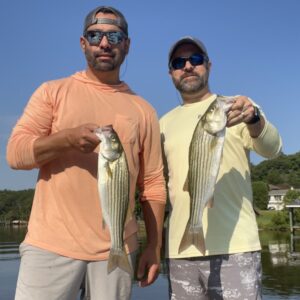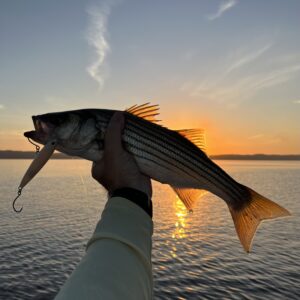Welcome to Reel Chesapeake’s Weekly Fishing Report, our interpretation of what’s biting and where throughout the Chesapeake Bay watershed. Please email us directly at editor@reelchesapeake.com to share updates and photographs of your recent catches for potential inclusion in next week’s column. The leading photograph (above): Striped bass caught on a 2” paddletail around 8:15 p.m. on September 5th, in Valentine Creek (Severn River) after the sun dipped below the horizon. Photo by yours truly.
Classic Maryland weather has been tricking us. We always get played this time of year. A cold front passes through, there’s a dip in temps, and we think we’re entering autumn. False fall. Then, a brutal heat wave. A week ago, I wrote of emergent fall patterns, birds, blowups, and wisps of cooler weather. Well, this week has been painfully hot and full of sunshine, which has pushed the bite downward in the water column. This is what we’re seeing firsthand in the middle Chesapeake river systems and even the open bay. Midday temperatures have had real-feels above 100F, while overnights have hovered in the 80s. This has slightly raised our surface water temps back into the high-70s/low 80s, making for less-than-ideal striper fishing overall. Even less-sensitive species are challenged. There’s still fishing to be enjoyed, but less so (maybe not at all) when the sun hits high-noon. This should change by the weekend, when flashes of rain pop through the region.
What we’ve seen are late-summer/early-fall patterns—primarily topwater or mid-morning swimming—having extremely narrow feeding windows at dawn and dusk; about 15–20 minutes before you have to work harder at finding and enticing the fish. Cloud cover was zero percent most mornings this week and the tides were slightly weaker. Wind has been mostly stable, under 15 knots. Flows and currents have been fair at best. Only around large structures and major points, sandbars, etc. is the current moving with noticeable velocity that would draw feeding fish.
Baitfish do remain abundant and have been the focus of the schooling striped bass, who are chasing them through the more open river stems and channels. Surface blitzes in the rivers last about 20 seconds before the fish dive back to deeper water—you’ll be lucky to catch from them (we threw XRap-style lures around the disappearing blitzes with limited success). A week ago, those mini-blitzes were upwards of a minute, making for fun “run and gun” style fishing. Now, a better bet may be slow trolling the shorelines in 4’ to 12’ depths quietly (kayaking or troll-motor) with 3–5” paddletails on light jigheads, lipless cranks, or shallow-diving minnows. All the mid-bay rivers are holding schoolies with plenty of 17” to 21”-plus size fish, which are fun on light setups.
Larger stripers in the mid-to-high-20s are certainly in the bay itself, but you’ll have to roam vast expanses to find the schools and plan to jig deeper water and major dropoffs on either side of the shipping channel. The Bay Bridge does remain popular for livelining spot, especially the eastern side. Your dawn and dusk options for topwater and shallower swimming (even fly fishing) include major points, like Fort Smallwood, Bodkin, Love, Sandy, Tolly, Thomas, Bloody, etc., and islands near river mouths like Hart Miller, Eastern Neck, Gibson, Poplar, and Tilghman. The further south you venture, your odds of hooking into bluefish, Spanish mackerel, red drum, and maybe even a cobia increase. These species have pushed more into the mid-bay recently though they may not stay for long.
White perch fishing has been good in the back ends of creeks within the rivers. They’re still holding in many upriver spots. No major push downstream yet, but that could begin in the coming week or two if temps start to consistently dip.
Snakehead fishing has been good in the “Baltimore rivers” and southward into the Patuxent and Potomac watersheds. The Blackwater system is also producing. Just know that as we near summer’s end, many of the Shore’s tribs have been fished hard for months—especially bowfished—so it’s not uncommon to come up empty, as crazy as that sounds. Regardless, the fish should start fall feeding mode soon, making for even more exciting action. Same with largemouth bass who’ll begin bulking up to overwinter. Expect the bite to really ignite with the next, significant cold front. Topwater frogs will remain an excellent first choice when fishing around dying pads and weeds. Wacky worms and colorful crankbaits, especially those imitating crawfish, can be deadly around hard cover, rocks, etc. (craws will be hitting their fall mating cycle soon).
With this week’s super high temps, I did see several similar reports of anglers heading to the shaded, shallow, flowing, and cool water creeks in the central Maryland region to fish for smallmouth bass. There’s respite in creek fishing and some great smallmouth up to the mid-teens can be taken from the upper Potomac, middle Patuxent, western Patapsco, and Monocacy rivers. Throw small grubs, tubes, worms, or even inline spinners. You may even hook into a holdover trout. Good luck!
This report appears within On The Water magazine’s weekly collection of Chesapeake Bay fishing reports.




